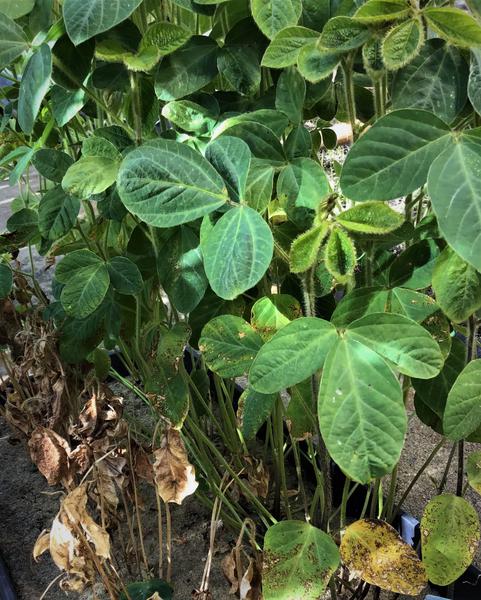Symptoms
Glufosinate (herbicide group [HG] 10) inhibits the production of glutamine, an amino acid used for chlorophyll production. Glufosinate is a contact herbicide, thus injury will only occur where the spray droplet lands on the soybean plant. Injury incurred by glufosinate includes chlorosis and necrosis. The development of glufosinate injury will be rapid and injury will be greater on hot, humid days. Glufosinate injury can occur on both glufosinate-resistant and –susceptible soybean varieties; however the injury on glufosinate-resistant soybeans will be transient while the glufosinate-susceptible varieties’ injury can range from transient to plant death depending on dose.
Management
Since glufosinate has no residual soil activity, non-glufosinate-tolerant soybeans cannot be injured via carry over. Injury will not be present on emerging soybean plants. Physical drift can be avoided by spraying when the average wind speed is less than 10 miles an hour and mid-day or –afternoon to avoid a temperature inversion.
Publication date: Jan. 11, 2021
N.C. Cooperative Extension prohibits discrimination and harassment regardless of age, color, disability, family and marital status, gender identity, national origin, political beliefs, race, religion, sex (including pregnancy), sexual orientation and veteran status.
NC Cooperative Extension prohíbe la discriminación por raza, color, nacionalidad, edad, sexo (incluyendo el embarazo), discapacidad, religión, orientación sexual, identidad de género, información genética, afiliación política, y estatus de veteran.
The use of brand names in this publication does not imply endorsement by NC State University or N.C. A&T State University of the products or services named nor discrimination against similar products or services not mentioned.
Recommendations for the use of agricultural chemicals are included in this publication as a convenience to the reader. The use of brand names and any mention or listing of commercial products or services in this publication does not imply endorsement by NC State University or N.C. A&T State University nor discrimination against similar products or services not mentioned. Individuals who use agricultural chemicals are responsible for ensuring that the intended use complies with current regulations and conforms to the product label. Be sure to obtain current information about usage regulations and examine a current product label before applying any chemical. For assistance, contact your local N.C. Cooperative Extension county center.
N.C. Cooperative Extension prohibits discrimination and harassment regardless of age, color, disability, family and marital status, gender identity, national origin, political beliefs, race, religion, sex (including pregnancy), sexual orientation and veteran status.

